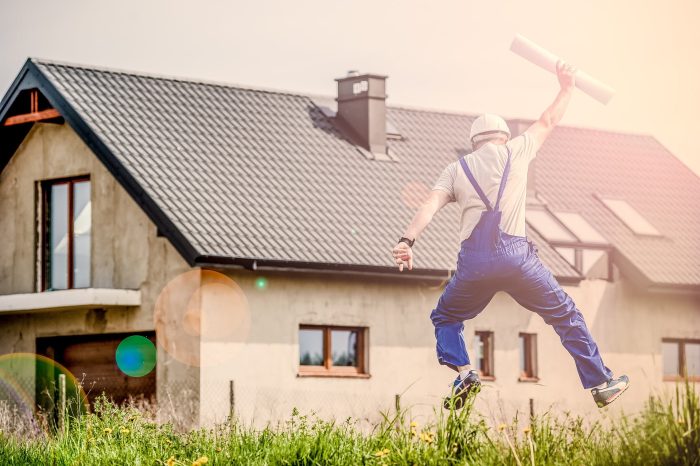Many people have lofty dreams of building their own home themselves on their land for pennies. However, the legality of the situation and what you’re allowed to do may throw a wrench into your well-laid plans. Here’s what you need to know if you want to build a house on your land.
For the purposes of this article, I’ll assume that you’ve already purchased some land. If you have, that means you’ll need to work within the laws of your county or state – which can vary widely across the country.
While it is “possible” to find a place where you’re allowed to build whatever you want without permits or building codes, those places are few and far between. So, if you’ve not yet bought land, be sure to research the building requirements for whatever you want to do.
This includes finding out about any deed restrictions from the owner that may ruin your plans, checking to see that it is suitable for a septic tank system if outside the city limits, and making sure no endangered critters live there which could keep you from building.
Confirm You Can Build
Step one is actually figuring out whether you can build on your land. For starters, there could be deed restrictions which prevent certain structures being built. Zoning of the property could prevent a lot from being used for a specific purpose as well.
Unfortunately, when it comes to cheap land – there’s normally a reason. Either that land is undesirable for some reason or impossible to build on – such as being in a protected wetland.
If you’re not sure, then take your information to your local building and planning office. They can advise you as to what you are allowed to do on your land and any issues which you may run into.
You’ll also probably want to get a land survey done at this point if you’ve not already to confirm the boundaries of your land and identify any potential issues with neighbors that could cause problems.
Figure Out Your Budget
After you have confirmed that you can indeed build on the lot it’s time to make a budget. We’ve done several articles on potential building costs and there are, of course, ways to save money here. The cheapest house to build per square foot will be simple in construction.
Or, you can potentially go even cheaper by utilizing a manufactured or modular home. These are built off-site and then delivered to your land whole or in pieces, saving you on costs. Though this method has its share of pitfalls to be aware of as well.
In addition, if you are handy you can try building it yourself. A long cabin kit is probably the cheapest possible way to build a house – that is if you don’t mind doing the labor to save on costs.
But, if you’d prefer to go the “stick built” route with a builder that knows what they’re doing you can expect to pay anywhere from $100 to $155 per sqft. Though you should keep in mind that this cost applies only to the home itself and you’ll be required to pay for any “extras”, which we’ll talk about in a minute.
Find A Builder Or A Kit Home
Once you’ve identified a budget, you can start looking for someone to build it. If that person is you, then you can start looking at kit homes you might want to construct. If you’re going with a professional, then you can start calling around for information.
Many of them should have pre-designed houses available which you can choose from. They can also likely point you in the right direction if you’re stuck and don’t know what to do next.
By the way, if you don’t yet already have land then the builder might also be able to help here. They often know where you can get some and how to buy land you can be sure will be build-able. The contractor, in most cases, also deals with pulling the permits for work and if you go the DIY route, this is another responsibility for you to handle.
Clearing The Land
Once you’ve settled on what you want to build, you’ll need to clear the land to get it ready for building. Decide how much land you want cleared and make sure you’ve removed enough to give the builder access for any machinery they may need to use during construction. The cost for this is about $1,500 to $5,000 per acre depending on how much work it is for the land clearing company.
Obviously, sparse vegetation is either to mow down and you’ll be on the lighter side of these costs. However, densely forested areas with a lot of debris and rocks in the way will drive up this number.
Next You’ll Need A Foundation
Before the builder can get started you need a foundation. This is typically taken care of before the builder even shows up and it’s a cost you’ll have in addition to the per sqft building prices quoted earlier.
Just “how much” you’ll have to pony up for this depends on what you want and this is a good opportunity to save money on your build if you need to. That’s because a basic foundation will run you somewhere around $8,000 but that price can quickly go up.
For example, if you’d like a full basement you can expect to pay something closer to $30,000. So, you’ll need to ask yourself if having one is really worth it the extra cost to you.
Get Your Utilities In Order
If you’re building within the city limits, this means getting the home ready for hook ups to sewer, water, and electricity. The costs for this vary greatly for each location and you may need to call your city to see how much this will cost you to have happen.
For those who are building outside the city a septic tank and a well will pretty much be guaranteed. The costs for these can be significant, so be sure to budget accordingly. Expect to pay $7,500+ for the well and $3,500+ for the septic tank system.
It can be surprisingly expensive to connect a home to sewer in some locations. You may pay anywhere from $5,000 to $20,000 for this. In addition, once sewer is offered many in-city locations do not allow you to install a septic tank and instead insist you pay to hook up to their system.
However, septic and well systems also have downsides. Septic tanks can get clogged and need to be pumped. Tanks can also be easily damaged by roots if you plant trees or large shrubs too close to them.
In addition, well water can either be really great or really bad depending on your location. The water can be hard on pipes and perhaps not safe to drink in some circumstances or locations.
Get Busy Building
At this point, you’ll finally be ready to build. The builder can now get started and begin pulling the necessary permits after your foundation is inspected. Or, if you’ll be building the house yourself you can begin doing this.
While you may think it’s time to take a breather at this point – nope! If you want a successful build you should be involved with the process every step of the way to make sure things are being done correctly.
Mistakes happen and keeping on top of things prevents delays and costly building errors.

Bob learned about farming from his grand dad. So, the decision to leave the city and start homesteading was not a difficult transition. He now lives with his wife and two kids on their 30 acre property in Ohio.





